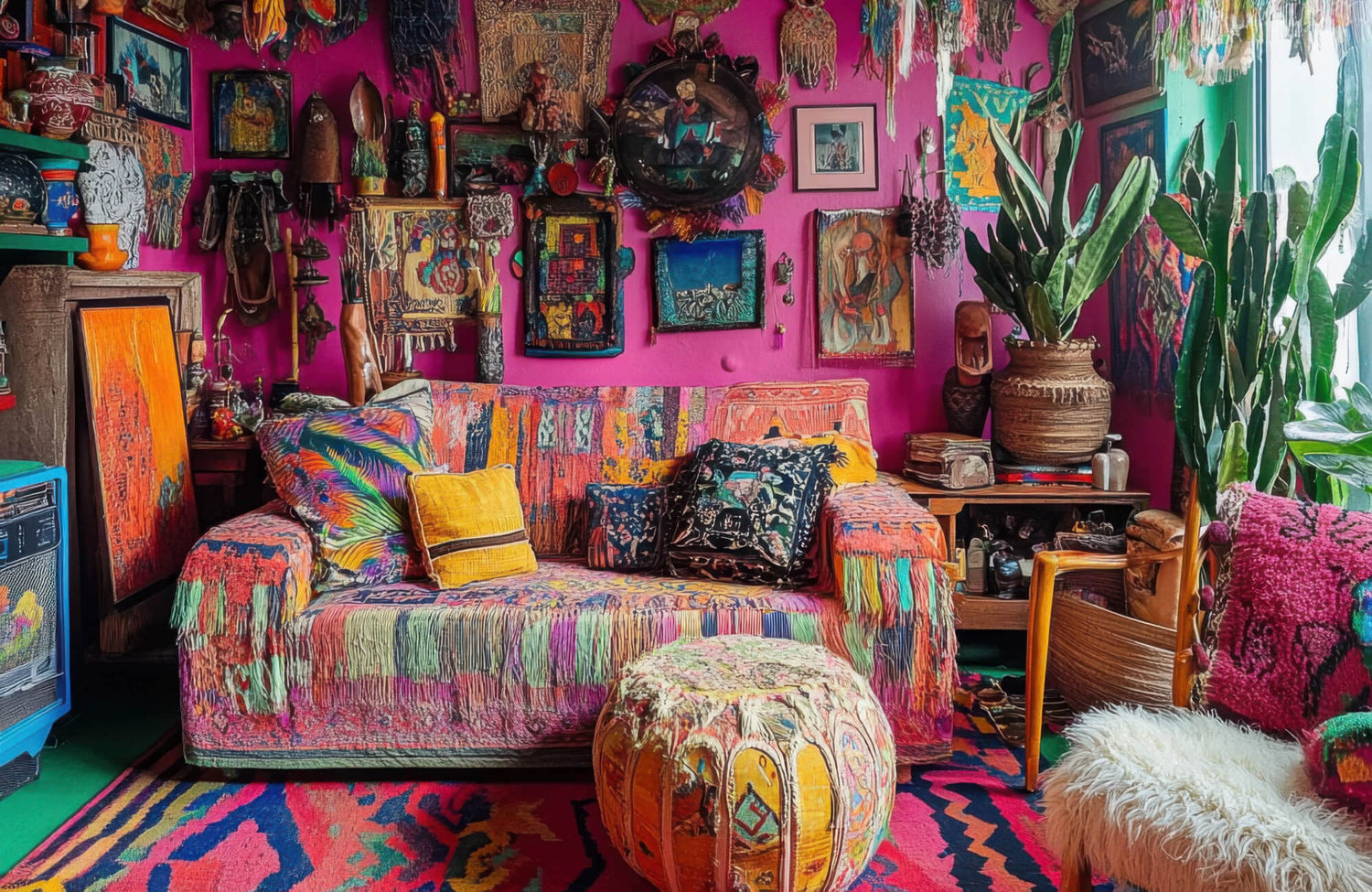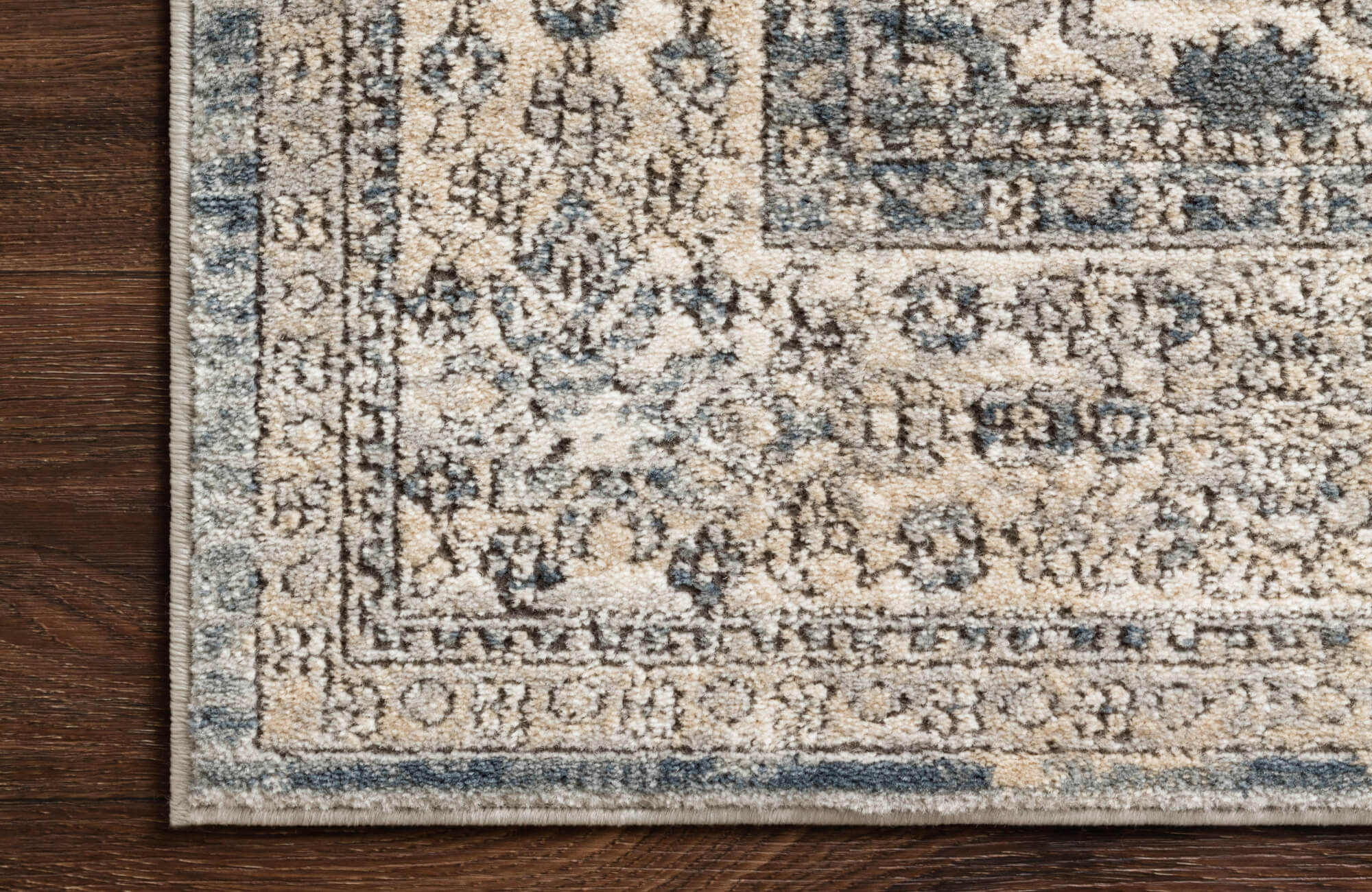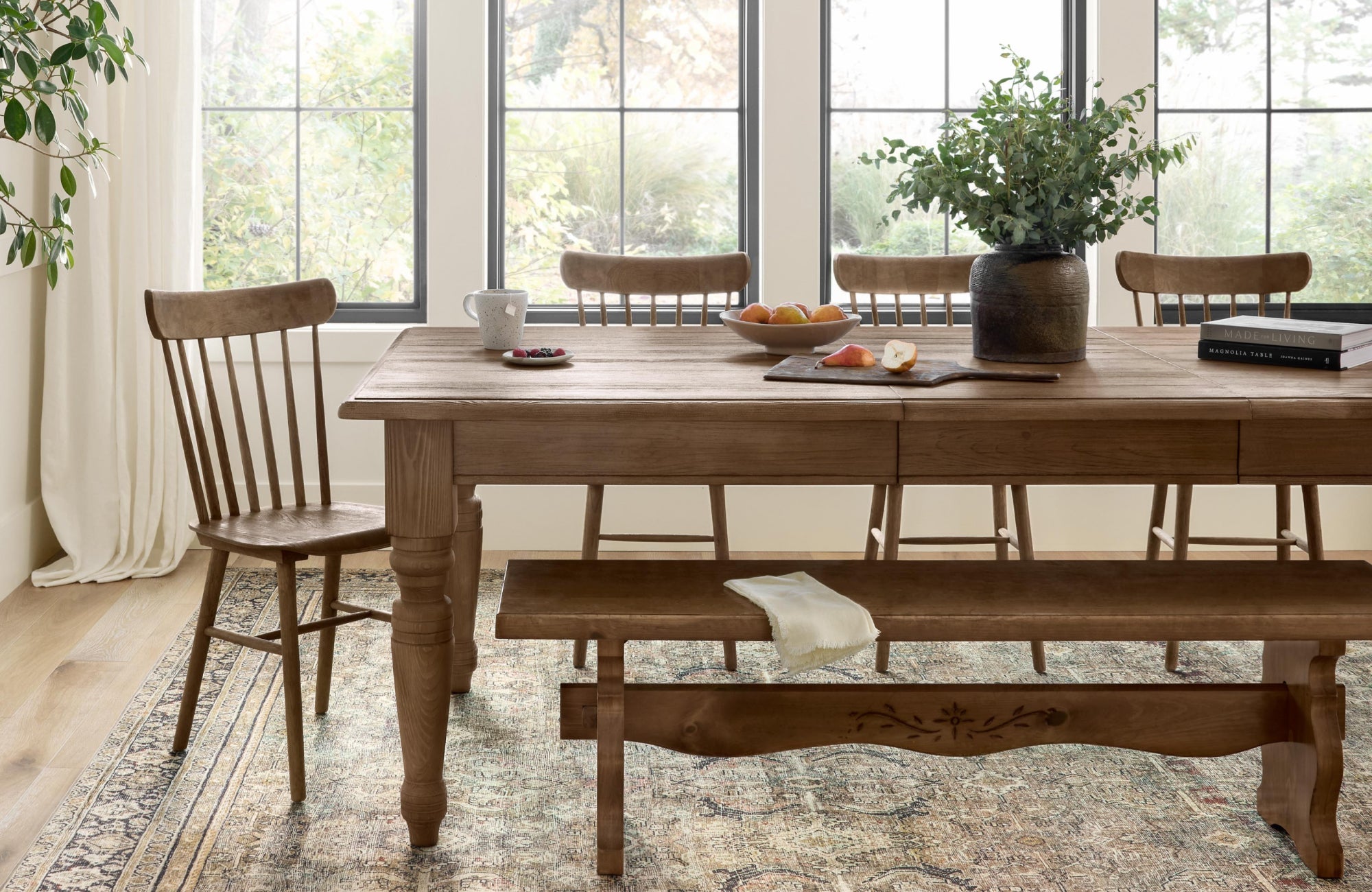A bold rug can do more than just add pattern or color, it can become the heartbeat of a maximalist room. From layering textures to highlighting vibrant palettes, rugs are one of the most expressive tools for tying together an eclectic space. Whether you're working with vintage finds, mixing motifs, or stacking rugs with intention, the right piece can ground your design or steal the show entirely.
In this guide, we’ll walk you through how to incorporate rugs into a maximalist interior with confidence. From layering techniques to mixing prints and choosing colors that energize a room, these tips are designed to help your rug choices feel curated and impactful. By the end, you’ll be equipped to style boldly and bring richness, balance, and personality into every corner of your home.

Layering Rugs with Purpose
Layering rugs is one of the most expressive tools in a maximalist space. It adds visual depth, texture, and a sense of curated abundance that reflects the heart of this style. Whether you're stacking bold over bold or blending muted tones with ornate patterns, how you layer can completely shift the energy of a room.
Rug-on-Rug Techniques
Stacking rugs might seem simple, but in maximalist design, it’s a thoughtful design decision. Try starting with a large neutral rug as your base, such as a flatweave or natural fiber option, then layer a bold, patterned rug on top to anchor the room. For instance, placing a vintage Persian rug over a solid jute base can introduce both color and character. Adjusting the placement, either centered beneath furniture or slightly off-angle, can also help guide the eye and create intentional contrast.
For an extra dimension, consider layering rugs of varying shapes, not just sizes. A circular rug placed over a rectangular one, for example, can help soften rigid furniture layouts and bring movement into boxy spaces. You can also rotate your top rug slightly to break symmetry and create a sense of collected spontaneity, which is perfect for the layered, lived-in feel of maximalism.
Mixing Textures and Materials
Layering with different textures is just as important as layering with patterns. Combining a soft shag with a structured flatweave, or pairing wool with jute, can add depth while keeping the look cohesive. For example, a high-pile rug layered over a kilim base adds softness without overpowering the design. To maintain balance, focus on materials that bring contrast while still feeling complementary in tone and texture.
It also helps to think about how texture contributes to function. A plush rug underfoot in a lounge area adds comfort, while a woven or low-pile base layer keeps the structure grounded. Texture can also guide the energy of the room. Rougher natural fibers can bring earthiness to bold schemes, while silky or high-pile finishes introduce a bit of glam or softness where needed.
Mixing Patterns and Textures
Maximalist interiors thrive on contrast, and mixing patterns and textures is one of the most effective ways to bring that idea to life through rugs. Bold prints like florals, tribal motifs, or geometric shapes can instantly create a focal point, especially when placed alongside different tactile finishes. For instance, pairing an ornate Persian rug with a minimal abstract runner adds a touch of surprise while still feeling curated.
To pull it off without overwhelming the space, consider combining pieces that share at least one unifying element, such as a shared color tone or complementary shape. This keeps the design layered and expressive without crossing into chaos. Texture plays an equally important role here; combining plush surfaces with flatter weaves invites visual movement and creates a contrast you can feel, not just see.

Choosing Colors That Complement the Chaos
Color plays a major role in any maximalist space, and rugs offer the perfect opportunity to either pull everything together or add even more personality. Rather than defaulting to neutrals, it’s better to embrace saturated tones such as deep reds, rich emeralds, cobalt blues, or vibrant multicolored blends. These hues can reflect other accents in the room, such as artwork or upholstery, helping the space feel layered and unified at the same time. For example, our Hutchinson Polyester Face Rug in Blush / Multi above can serve as both a grounding base and a captivating focal point.
Rug color can also be used strategically to balance a room’s energy. If your walls and furniture already feature busy patterns, a rug that repeats one of the existing colors can quietly support the overall composition without overwhelming it. On the other hand, if you want the rug to stand out, choose a palette that contrasts with your surroundings while still feeling intentional. Try echoing one or two of those bold tones in nearby accessories like a throw, lamp, or vase to maintain a sense of cohesion.

Styling Tips for Different Rooms
Maximalist design thrives on bold, expressive choices, but rug placement still needs intention behind it. Each room comes with different needs, and the right rug can elevate function while contributing to the overall visual story. Below, we’ll walk through room-specific tips to help you choose and style rugs that bring cohesion, contrast, and personality into every corner of your home.
Living Room
In the living room, rugs can do more than add color, they can help define the space. For example, an oversized rug that fits beneath the entire seating area creates a strong foundation and ties all furniture pieces together. You can also layer rugs to highlight a specific area, like placing a smaller patterned rug over a solid one to anchor a coffee table or conversation nook. This not only adds texture and contrast but also helps section off parts of an open layout without using walls.
To take it a step further, consider how the rug interacts with other statement elements in the room. For instance, if you have a bold gallery wall or patterned curtains, choose a rug that complements rather than competes, perhaps by echoing a dominant color or softening the room’s rhythm. You can also experiment with asymmetry, placing rugs slightly off-center to create movement or frame a favorite seating piece. This layering of visual intention helps make the space feel full, not cluttered.
Bedroom
Bedrooms in maximalist homes offer a great chance to mix coziness with bold styling. A statement rug that extends beyond the bed’s edges adds softness underfoot while visually framing the bed as the centerpiece. You might choose a patterned or richly textured option that contrasts with your bedding or flooring. For added dimension, try layering a high-pile rug over a flatter one for both comfort and visual intrigue.
You can also use rugs to separate functional zones within your bedroom. For example, a smaller rug under a reading chair or vanity can carve out distinct areas without breaking the room’s cohesion. Don’t be afraid to play with shape here; round rugs under side tables or layered runners beside the bed can add interest while reinforcing the room’s layered character. In maximalist bedrooms, it’s less about symmetry and more about personality, so let your rug choices reflect your unique rhythm.
Dining Room
The dining room is a space where rugs can highlight your table setting and create a frame that feels intentional. Choose a rug large enough to let chairs stay on it even when pulled out, which keeps the visual balance intact and prevents awkward transitions. Pair a bold pattern with either matching or contrasting chair upholstery to reinforce your design direction. Even in functional areas like this, maximalism encourages play, so don’t be afraid to go for texture, rich color, or something slightly unexpected.
Another smart trick is to play with repetition across rug and table décor. For instance, if your rug features deep burgundy tones, a similarly hued table runner or a bold set of dinnerware can help carry the color story upward. If you’re layering rugs, you might use a neutral base under a patterned top rug to keep things grounded while still expressive. Since the dining area sees movement, consider rugs with low pile or stain-resistant materials that still pack a visual punch.

Vintage and Global-Inspired Pieces
In maximalist design, vintage and globally inspired rugs bring more than just color and pattern; they tell a story. Each handwoven piece, such as our Marcela Cotten Blend Rug in Natural / Ocean above, carries its own history, often showcasing techniques and motifs passed down through generations. Whether it’s a kilim from Turkey or a Persian-style rug from a local market, incorporating these finds adds richness and depth to your space. They also help ground more modern pieces, offering a contrast that feels intentional rather than random.
You can layer a timeworn rug over a contemporary base or place it beneath sleek, modern furniture for high-impact contrast. For instance, a low-profile vintage rug under a sculptural coffee table or alongside vibrant wall art creates visual intrigue without feeling forced. It’s not about matching styles perfectly but allowing the character of the rug to play off the other bold elements in the room. This kind of layered storytelling is what gives maximalist interiors their soul and authenticity.
Balancing Boldness
To keep vintage or global pieces from clashing with other expressive elements in the room, it helps to establish a clear visual anchor. A bold rug can serve as that focal point while the surrounding décor takes on a more supportive role. For example, if the rug is intricate and colorful, you might soften nearby furniture with solid tones or more subdued textures to prevent the space from feeling too chaotic.
The goal isn't to tone down your style but to guide the eye with intention. When one element, such as a standout rug, takes the lead, everything else can fall into place more naturally. This approach lets you embrace maximalist richness while still achieving a sense of balance, clarity, and visual flow.

Maintenance and Practicality in Maximalist Rooms
Even in high-energy, design-heavy spaces, practicality still plays a role, especially when it comes to rugs. With so many visual layers at play, it helps to choose rugs that are easy to clean and maintain without sacrificing their visual appeal. For example, low-pile options like flatweaves or synthetic blends are easier to manage while still contributing bold patterns and texture to the room.
Materials such as polypropylene, wool blends, or even washable cotton rugs such as our Marcela Cotten Blend Rug in Sage / Sand are excellent choices for busy households. They offer the durability you need in busy areas while still delivering the color and pattern that maximalist spaces thrive on. The key is to prioritize practicality in a way that feels seamless within your aesthetic so your room stays expressive and functional without the extra upkeep.
To extend the life of your rugs, consider using rug pads underneath to prevent slipping and reduce wear, especially in layered setups. Also, rotating rugs every few months can help distribute wear and tear evenly and prevent fading in sun-exposed areas. These small maintenance habits will keep your bold rug choices looking intentional and vibrant for the long haul.
Incorporating Rugs with Intention and Personality
Incorporating rugs into a maximalist design is all about embracing intention, contrast, and personality. From layering different textures and patterns to choosing bold colors that energize the space, rugs have the power to anchor your design while adding richness and depth. The goal isn’t perfection, it’s curation. When every piece feels collected with purpose, your space becomes a true reflection of your bold, expressive style.
If you’re exploring which rug combinations work best for your home, our team at Edward Martin is here to help. Contact us today to schedule a personalized design consultation. We’ll guide you through material options, size considerations, and styling techniques so you can confidently build a layered, maximalist space that feels vibrant, lived-in, and entirely your own.







